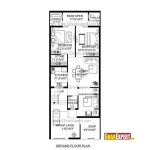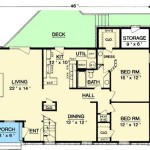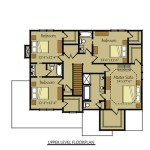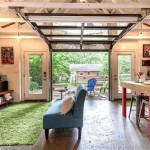Small Home Plans For Retirement: Downsizing and Designing for the Future
Retirement often signifies a significant shift in lifestyle, prompting individuals to re-evaluate their living arrangements. For many, the traditional family home, once filled with the energy of raising children, can become burdensome and disproportionately large for a retired couple or individual. This has led to a growing interest in small home plans specifically designed for retirement living. These plans prioritize affordability, accessibility, ease of maintenance, and community, offering a compelling alternative to larger, more demanding properties.
The allure of small homes for retirement stems from a confluence of factors. Financial considerations play a major role, as downsizing can free up capital for travel, hobbies, or healthcare expenses. Reduced utility bills and property taxes associated with smaller square footage significantly contribute to long-term savings. Furthermore, the simplicity of maintaining a smaller home allows retirees to dedicate more time to activities they enjoy, rather than being burdened by extensive housework and yard work.
This article explores the key considerations when selecting small home plans for retirement, focusing on the design elements, features, and lifestyle benefits that make these homes an attractive option for those entering this new phase of life. It will delve into the different styles available, the importance of accessibility features, and the benefits of community living, providing a comprehensive overview of small home plans tailored for retirement needs.
Key Considerations for Small Home Plans in Retirement
Selecting the right small home plan for retirement requires careful consideration of individual needs and preferences. The following aspects are crucial in ensuring the chosen home maximizes comfort, convenience, and long-term suitability.
Budget & Financial Planning: The first step is a thorough assessment of financial resources. Establishing a realistic budget is essential, encompassing not only the initial purchase price or construction costs but also ongoing expenses such as property taxes, insurance, maintenance, and potential homeowners association (HOA) fees. Downsizing often provides an opportunity to unlock equity from a larger home, which can be used to finance the new purchase or provide a financial cushion for retirement. It's important to consult with a financial advisor to understand the long-term financial implications of downsizing and to create a sustainable retirement budget that incorporates housing costs.
Location, Location, Location: The importance of location cannot be overstated. Access to healthcare facilities, shopping centers, recreational amenities, and social opportunities are vital for a fulfilling retirement lifestyle. Proximity to family and friends is also a significant factor for many individuals. Consider the climate, local taxes, and the overall community atmosphere when evaluating potential locations. Some retirees prefer the peace and tranquility of rural settings, while others thrive in the vibrancy of urban environments. Evaluate the availability of public transportation, as driving may become less appealing or possible in later years. Research crime rates and local services to ensure a safe and comfortable living environment.
Future Needs and Accessibility: Planning for potential future needs is paramount when choosing a retirement home. Accessibility features, such as wider doorways, grab bars in bathrooms, and ramps instead of stairs, can significantly enhance safety and independence as mobility decreases. Single-story homes or those with elevators eliminate the challenges of navigating stairs. Consider the potential for aging in place and choose a home that can be easily adapted to accommodate changing needs. Universal design principles, which incorporate features that are both aesthetically pleasing and functional for people of all ages and abilities, should be prioritized. This includes things like lever door handles, adjustable countertops, and roll-in showers.
Design Elements and Features of Small Retirement Homes
Small home plans for retirement prioritize efficient space utilization and thoughtful design to maximize comfort and functionality within a smaller footprint. Several key design elements and features contribute to the livability of these homes.
Open Floor Plans: Open floor plans, combining living, dining, and kitchen areas, create a sense of spaciousness and facilitate social interaction. This design also allows for better natural light penetration, making the home feel brighter and more inviting. Clear sightlines throughout the main living area enhance safety and allow for easy monitoring of activities. Open floor plans are particularly beneficial for individuals with mobility limitations, as they eliminate the need to navigate narrow hallways or cramped spaces.
Minimalism and Storage Solutions: Downsizing inherently requires a conscious effort to declutter and embrace a minimalist lifestyle. Ample storage solutions are essential for maintaining an organized and clutter-free living environment. Built-in shelving, custom cabinetry, and clever storage compartments maximize space and minimize visual clutter. Consider utilizing vertical space with tall cabinets and shelving units to maximize storage capacity. Furthermore, explore innovative storage solutions such as under-bed storage, pull-out drawers, and multi-functional furniture.
Outdoor Living Spaces: Outdoor living spaces, such as patios, decks, and screened porches, extend the living area and provide opportunities for relaxation and recreation. These spaces are particularly appealing for retirees who enjoy gardening, entertaining, or simply relaxing outdoors. Consider the orientation of the outdoor space to maximize sunlight or shade, depending on the climate. Incorporate comfortable seating, outdoor lighting, and potentially an outdoor kitchen or grilling area to create an inviting and functional outdoor living space. Low-maintenance landscaping can further enhance the appeal of the outdoor area while minimizing upkeep.
Exploring Different Styles of Small Retirement Homes
Small home plans for retirement come in a variety of architectural styles, each offering unique aesthetic appeal and practical advantages. Exploring different styles can help individuals find a home that aligns with their personal preferences and lifestyle.
Cottage Style: Cottage-style homes are characterized by their charming and cozy aesthetic. Features such as gabled roofs, dormer windows, and inviting front porches create a welcoming atmosphere. Cottage-style homes often incorporate natural materials, such as wood siding and stone accents, further enhancing their rustic appeal. These homes are well-suited for smaller lots and often feature integrated gardens or landscaping, making them ideal for retirees who enjoy gardening or spending time outdoors. The intimate scale of cottage-style homes lends itself well to easy maintenance and a sense of community.
Ranch Style: Ranch-style homes are typically single-story, making them an excellent choice for individuals with mobility limitations. Their simple and open floor plans promote accessibility and ease of movement. Ranch-style homes often feature large windows that provide ample natural light and allow for easy access to the outdoors. These homes are typically built on slab foundations, eliminating the need for stairs or basements. The horizontal layout of ranch-style homes makes them ideal for aging in place, as they can be easily adapted to accommodate changing needs.
Condominiums and Townhomes: Condominiums and townhomes offer a maintenance-free lifestyle, as exterior upkeep and landscaping are typically handled by the homeowners association. These types of homes often feature shared amenities such as swimming pools, fitness centers, and community rooms, promoting social interaction and a sense of community. Condominiums and townhomes can be a more affordable option compared to single-family homes, particularly in urban areas. They also provide added security, as they are often located in gated communities or have security systems in place. The compact size of condominiums and townhomes makes them easy to manage and ideal for retirees who are seeking a low-maintenance living option.
Beyond these styles, other options include modern tiny homes, which maximize space efficiency through innovative design and multi-functional elements, and manufactured homes, which offer an affordable and relatively quick construction process. The best choice will vary based on individual budget, location preferences, and desired level of customization.

Small One Story 2 Bedroom Retirement House Plans Houseplans Blog Com
:max_bytes(150000):strip_icc()/sparta-SL-1810-85462ab99fbd4675a64de1775c6d1bdf.jpg?strip=all)
15 Dreamy House Plans Built For Retirement

Small One Story 2 Bedroom Retirement House Plans Houseplans Blog Com

Small One Story 2 Bedroom Retirement House Plans Houseplans Blog Com

Empty Nester House Plans Retirement The Designers

Small One Story 2 Bedroom Retirement House Plans Houseplans Blog Com
:max_bytes(150000):strip_icc()/SL-2009--e70851d071694f7294fb8e47d3dd74d5.jpg?strip=all)
15 Dreamy House Plans Built For Retirement

Small One Story 2 Bedroom Retirement House Plans Houseplans Blog Com

Luxury Retirement Communities For Active S And 55 Seniors Property Montecito New House Plans Dream Small
:max_bytes(150000):strip_icc()/1375tideland_4c_ext-364758e42ee5467a8500d2be5ec8ba25.jpg?strip=all)
15 Dreamy House Plans Built For Retirement








